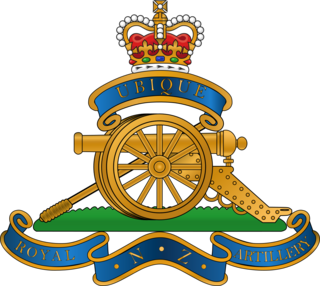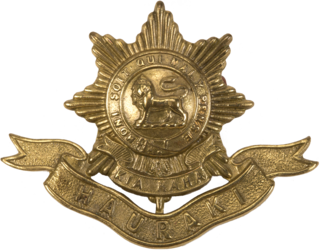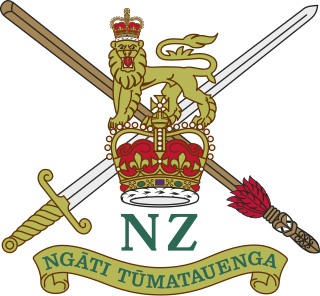
The Royal New Zealand Infantry Regiment is the parent administrative regiment and corps of regular and reserve infantry battalions in the New Zealand Army. It was originally formed in 1947 with a singular Regular regiment and multiple reserve regiments. Over time, the regiments were turned into battalions, the reserve units amalgamated and more regular units raised and disbanded. Currently, the Regiment currently consists of two regular and three reserve battalions. Throughout its existence, units raised in this regiment have served and deployed on operations in Malaya, Vietnam, Borneo and various United Nations peacekeeping operations.

The Royal Regiment of New Zealand Artillery is the artillery regiment of the New Zealand Army. It is effectively a military administrative corps, and can comprise multiple component regiments. This nomenclature stems from its heritage as an offshoot of the British Army's Royal Artillery. In its current form it was founded in 1947 with the amalgamation of the regular and volunteer corps of artillery in New Zealand. In 1958 in recognition of services rendered it was given the title the Royal Regiment of New Zealand Artillery.
The Rifles is an infantry regiment of the British Army. Formed in 2007, it consists of four Regular battalions and three Reserve battalions. Each Regular battalion of The Rifles was formerly an individual battalion of one of the two large regiments of the Light Division. Since formation, the regiment has been involved in combat operations in the later stages of the Iraq War and in the War in Afghanistan.
The Wellington (City of Wellington's Own) and Hawke's Bay Regiment was a Territorial Force (TF) regiment of the New Zealand Army. It was formed in 1964 during the reorganisation of the army by the amalgamation of two separate regiments:

The Hauraki Regiment was a Territorial Force unit of the New Zealand Army. The regiment was formed as the 2nd (Hauraki) Battalion, Auckland Rifle Volunteers. Men of the Hauraki Regiment served during the First World War with the various Auckland Regiments, and with the 18th, 21st, 24th and 29th Battalions of the NZEF in the Second World War.
The Wellington West Coast and Taranaki Regiment was a Territorial Force unit of the New Zealand Army. It was originally formed in 1948 by the amalgamation of two separate regiments:
The Otago and Southland Regiment (1948-2012) was a Territorial Force unit of the New Zealand Army. It saw service from 1959 to 1963 during the Malayan Emergency. In 1964 the unit was renamed the 4th Otago and Southland Battalion Group. The Regiments motto was Kia Mate Toa and Regimental Belt had the Mackenzie Tartan pattern of the Queen's Own Highlanders. The regimental badge uniquely contained a full Māori chief.

The Brockville Rifles is a Primary Reserve infantry regiment of the Canadian Army. The unit is a part of the 33 Canadian Brigade Group, 4th Canadian Division. It is fifteenth in the order of precedence of Canadian Army Infantry Regiments.
The 28th Infantry Brigade was a British Army formation which served during the First World War, the Second World War, The Malayan Emergency and Indonesian Confrontation.

The 1st Brigade is currently the largest unit of the New Zealand Army, and contains most of the army's deployable units. The brigade was formed on 13 December 2011 by amalgamating the 2nd Land Force Group and 3rd Land Force Group. Its establishment formed part of the 'Army 2015' package of reforms.

This article describes the current structure of the New Zealand Army. It includes the army's order of battle and the headquarters locations of major units.
The 1st Division was one of three New Zealand Army home defence divisions formed during World War II. The unit was established on 1 November 1941 and was responsible for protecting the northern region of New Zealand's North Island from invasion. The 1st Division was placed on alert during the early months of the Pacific War, but no threat developed. The division was greatly reduced in size during 1943 and was disbanded on 1 April 1944.

The 5th/7th Battalion, Royal New Zealand Infantry Regiment is an Army Reserve infantry battalion of the Royal New Zealand Infantry Regiment with its headquarters in Trentham, New Zealand.
The 3rd Battalion, Yorkshire Volunteers was an infantry battalion of the only full Territorial Army (TA) regiment in Yorkshire. The battalion was formed along with the 2nd Battalion of the same regiment in 1971. However, in 1992 following the end of the Cold War, the 3rd and 4th battalions amalgamated, thus ending the official lineage.
The 1919 King's Birthday Honours in New Zealand, celebrating the official birthday of King George V, were appointments made by the King on the recommendation of the New Zealand government to various orders and honours to reward and highlight good works by New Zealanders. They were announced on or dated 3 June 1919.

The Wellington Regiment (City of Wellington's Own) was a territorial infantry regiment of the New Zealand Army. The regiment traced its origins to the Wellington Veteran Volunteer Corps, a volunteer corps formed in 1867 and which would later amalgamate with other volunteer corps to form the 5th (Wellington) Regiment in 1911. During the First World War, the regiment was first sent to capture German Samoa in August 1914 and was later affiliated with the New Zealand Rifle Brigade which saw combat on the Western Front. After the war, the regiment was renamed the Wellington Regiment and remained in New Zealand for home defence during the Second World War. Men from the regiment, however, served with the 19th, 22nd, 25th and 36th Battalions of the Second New Zealand Expeditionary Force. In 1964, the Wellington Regiment was amalgamated with the Hawke's Bay Regiment to become 7th Battalion (Wellington (City of Wellington's Own) and Hawke's Bay), Royal New Zealand Infantry Regiment. The 7th Battalion was itself later amalgamated with the 5th Battalion and became 5th/7th Battalion, Royal New Zealand Infantry Regiment in 2012. The traditions of the Wellington Regiment are now continued by Wellington Company, 5/7 RNZIR.

The 2nd Māori Battalion was a territorial battalion of the New Zealand Military Forces during the Second World War. The battalion was formed in February 1942 as the 3rd battalion, North Auckland Regiment by converting a battalion of the National Military Reserve. The 2nd Māori Battalion garrisoned fortress areas in Northland and also provided training for personnel who would be latter posted overseas with 28th (Māori) Battalion. It was disbanded in 1944 along with most other territorial units.

The Hawke's Bay Regiment was a territorial infantry regiment of the New Zealand Military Forces. The regiment traced its origins to the Napier Rifle Volunteer Rifles, a volunteer corps formed in 1863 and which would later amalgamate with other volunteer corps to form the 9th Regiment in 1911. During the First World War, the regiment provided a company to each of the battalions of the Wellington Infantry Regiment and saw combat at Galipolli and on the Western Front. After the war the regiment was renamed the Hawke's Bay Regiment and remained in New Zealand for home defense during the Second World War. Men from the regiment, however, served with the 19th, 22nd, 25th and 36th Battalions of the Second New Zealand Expeditionary Force. The regiment had a close relationship with the Ruahine Regiment, which was detached and reabsorbed by the Hawke's Bay regiment on two separate occasions. In 1964, the Hawkes Bay regiment was amalgamated with the Wellington Regiment and become the 7th Battalion, Royal New Zealand Infantry Regiment

The Ruahine Regiment was a Territorial Force Infantry Regiment of the New Zealand Military Forces. It was briefly raised in the 1910s and saw service in the First World War as part of the Wellington Infantry Regiment. It was formed for a second time during the Second World War and was deployed overseas as part of the 3rd Division but never saw combat.

The Northland Regiment was a territorial infantry regiment of the New Zealand Military Forces. The Regiment was formed in 1911 and provided service companies to the Auckland Infantry Regiment during the First World War. Men from the Regiment also served with the 18th, 21st, 24th and 29th battalions of the 2nd New Zealand Expeditionary Force during the Second World War. The regiment was amalgamated with the Auckland Regiment in 1964, becoming 3rd Battalion, Royal New Zealand Infantry Regiment.











